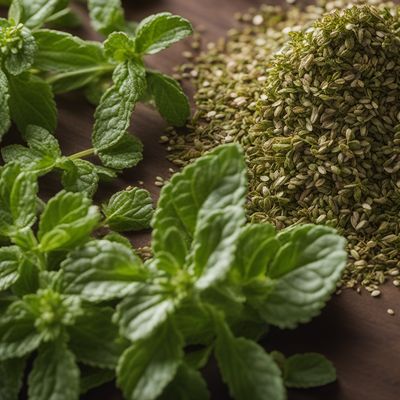
Ingredient
Summer savory
"The Herb of Warmth and Flavor"
Summer savory is a small, bushy herb with slender, green leaves and delicate white flowers. It has a pleasant, aromatic fragrance and a slightly peppery taste with hints of mint and thyme. The leaves are tender and can be used fresh or dried, while the flowers are edible and make a beautiful garnish. Its texture is soft and delicate, making it easy to incorporate into various recipes.
Origins and history
Summer savory, scientifically known as Satureja hortensis, is native to the Mediterranean region and has been used in culinary and medicinal applications for centuries. It was highly valued by the ancient Romans and Greeks for its aromatic properties and was believed to have aphrodisiac qualities. Over time, it spread to other parts of Europe and eventually made its way to North America.
Nutritional information
Summer savory is a good source of vitamins A and C, as well as minerals like iron and calcium. It is low in calories, with approximately 30 calories per 100 grams.
Allergens
There are no known allergens associated with summer savory.
How to select
When selecting summer savory, look for fresh, vibrant green leaves without any signs of wilting or discoloration. The leaves should have a strong aroma when gently crushed. If purchasing dried summer savory, ensure that it is stored in an airtight container to maintain its freshness.
Storage recommendations
To keep summer savory fresh, store it in the refrigerator wrapped in a damp paper towel or in a plastic bag. Alternatively, you can dry the leaves by hanging them upside down in a cool, dry place and store them in an airtight container.
How to produce
Summer savory can be easily grown in a sunny spot in your garden or in a pot on your windowsill. It prefers well-drained soil and regular watering. Sow the seeds in early spring and harvest the leaves as needed throughout the growing season.
Preparation tips
Summer savory can be used in both fresh and dried forms. Add it to soups, stews, and sauces for a savory flavor boost. It pairs well with beans, vegetables, and meats, particularly poultry and lamb. It can also be infused into oils or vinegars for added depth of flavor. Remember to add summer savory towards the end of cooking to preserve its delicate taste.
Substitutions
If summer savory is not available, thyme can be used as a substitute due to its similar earthy and minty flavor profiles.
Culinary uses
Summer savory is commonly used in Mediterranean, European, and North American cuisines. It is a key ingredient in herbes de Provence and is often used in bean dishes, sausages, stuffings, and marinades. It also adds a delightful flavor to roasted vegetables and grilled meats.
Availability
Summer savory is commonly available in Europe, North America, and the Mediterranean region.
More ingredients from this category

Syrian oregano
The Exotic Herb: Syrian Oregano

Winter savory
Savoring the Season: Exploring the Delights of Winter Savory

Thyme
The Fragrant Herb: Thyme

Mastic thyme
The Fragrant Herb: Unveiling the Aromatic Delights of Mastic Thyme

Creeping thyme
The Fragrant Delight of Creeping Thyme

Oregano
The Herb of Mediterranean Delights

Lemon thyme
The Zesty Herb

Marjoram
The Fragrant Herb: Marjoram

Lemon savory
The Zesty Herb: Lemon Savory and its Citrusy Twist

Cretan oregano
The Fragrant Herb of the Mediterranean